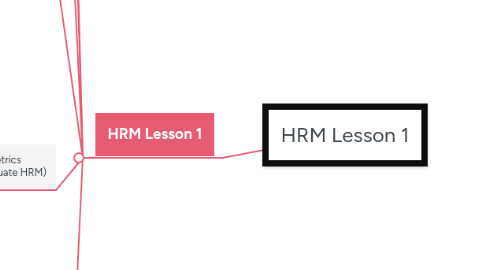
1. HRM Lesson 1
1.1. Definition of HRM
1.2. Roles and goals of HRM
1.2.1. Who does HRM?
1.2.1.1. HR Department
1.2.1.1.1. - Design & manage the HR system, including. policies, procedures and record keeping - Work with line to implement the HR system or solution - Advise, assist and mediate on HRM issues
1.2.1.2. Line Managers/Supervisors
1.2.1.2.1. - Provide input on HR needs - Work with HR Dept. to carry out the HR functions in relation to managing staff in own departments - Manage HR issues with staff
1.3. 7 HR Functional Areas (Key tasks for HR team)
1.3.1. Resourcing: Manpower Planning
1.3.1.1. Assessment of workforce to determine future requirements and to identify manpower gaps, in alignment with business planning
1.3.2. Resourcing: Recruitment, Selection and Termination
1.3.2.1. Processes associated with sourcing for and selecting suitable people for jobs as well as implementing solutions to manage manpower such as termination of services
1.3.3. Compensation and Benefits
1.3.3.1. Processes related to implementing suitable compensation and benefits (including work-life) strategies and programmes
1.3.4. Performance Management
1.3.4.1. Processes related to managing employee job performance through the use of goal setting, appraisal, coaching and feedback
1.3.5. Talent Management
1.3.5.1. Strategies and programmes to facilitate the management of high potential employees as well as the career development of staff across the organisation
1.3.6. Learning and Development
1.3.6.1. Processes related to broad suite of activities that develop employees’ capabilities to meet organisational and personal goals
1.3.7. Employee Relations
1.3.7.1. Activities associated with managing employee relationships with the organisation, including managing the union, engaging employees and assisting with employee grievances
1.4. Strategic Contribution of HRM
1.4.1. Organisation mission
1.4.1.1. Business - Where and how do we function or compete in the market to achieve the mission? Decisions - between business and human resources management (HRM)
1.4.1.2. HRM - Can the business strategy work given human resource capabilities? - How to attract & retain the right people in right jobs, at the right time based on business needs? - How to enable & motivate people to do the right things right?
1.5. 3 HR Metrics (To evaluate HRM)
1.5.1. Return-on-Investment (ROI) - to measure productivity
1.5.1.1. ROI = Revenue - Operating cost (including manpower cost) / Manpower cost
1.5.1.1.1. Profit ($) generated for every dollar spent on people
1.5.2. Resignation Rate - to measure effectiveness (Turnover rate)
1.5.2.1. Resignation rate = Number of resignations / Average numbers of staff X 100%
1.5.2.1.1. % of staff who leave the organisation each period
1.5.3. Average Time-to-Fill (TOF) - to measure efficiency
1.5.3.1. Score on Staff Satisfaction Survey [Effectiveness] TOF = Total numbers of days all positions will vacant is (Offer acceptance dates - Hiring approval dates) / Numbers of people hired
1.5.3.1.1. Number of days it takes to complete recruitment
1.6. Influences on HR Practice
1.6.1. 5 External Factors
1.6.1.1. Government
1.6.1.1.1. Employment Act
1.6.1.1.2. Workplace Safety and Health Act
1.6.1.1.3. Central Provident Fund (CPF) Act
1.6.1.1.4. Retirement and Re-employment Act
1.6.1.1.5. Employment of Foreign Manpower Act
1.6.1.2. Labour Market
1.6.1.2.1. Demand for manpower (in specific occupational areas or in general) and availability of suitable people
1.6.1.3. Industry
1.6.1.3.1. HR practices can be benchmarked against the industry for reference on organisational performance as well as to maintain equity or gain an advantage.
1.6.1.4. Shareholders
1.6.1.4.1. Shareholders are those who have a financial investment in a company, but are not involved in the management of the company’s business (which is the responsibility of the appointed board of directors)
1.6.1.5. Technology
1.6.1.5.1. - Technology enables automation of HR work as well as allows for new work arrangements for staff - HR practices also need to keep up with advancements in technology
1.6.2. 5 Internal Factors
1.6.2.1. Organisational Needs
1.6.2.1.1. Type of HR practices adopted depends on the strategic objectives, nature of business and business operational needs of the organisation
1.6.2.2. Management Culture
1.6.2.2.1. - By approving or rejecting HRM policies, the management has direct control of HR practices - Beliefs and priorities of the management in managing their employees also provide direction for HR practices in an organisation
1.6.2.3. Resources / Return on Investment (ROI)
1.6.2.3.1. Availability of money, time and manpower as well as the worthwhileness of doing an activity must be considered when making HR decisions
1.6.2.4. Employees
1.6.2.4.1. - Unions (representing the employees) may negotiate the compensation and benefits offered by an organisation - The demographics, skill sets and job expectations of the employees also guide the HR practices adopted
1.6.2.5. Structure
1.6.2.5.1. Size and structure of an organisation can affect the type and complexity of the HR practices in the organisation

